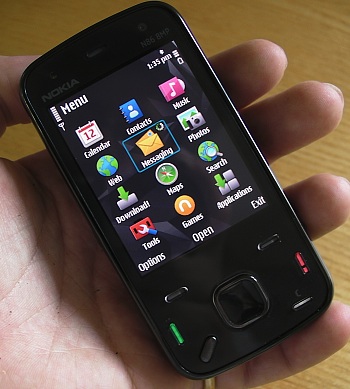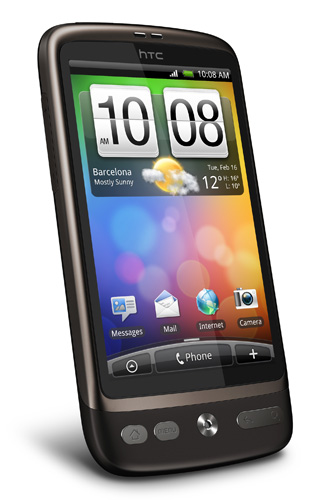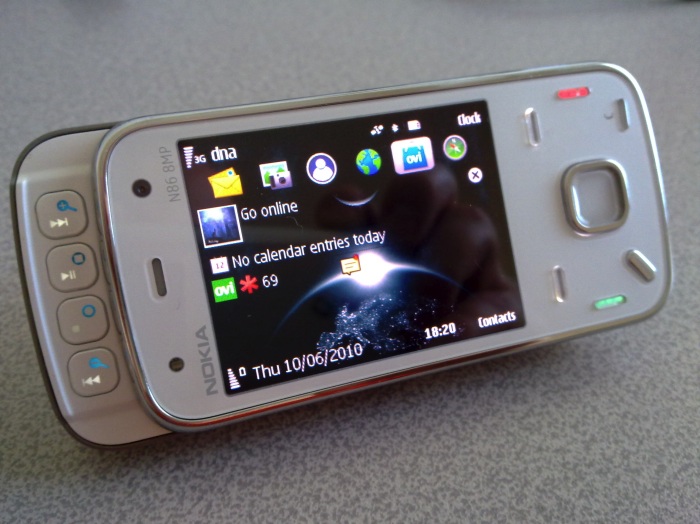From part one:
However, having played with many low end phones over the last few months (from LG Cookies to Nokia Series 40 to Sony Ericsson Wseries devices), I've come to the conclusion that there's a still a wide gulf in terms of ability between these units and true 'smartphones'. The apps, the multitasking, the better browsers, the high specs, the larger screens - ALL of these factors make a smartphone smart. And so the term is still relevant, it's just singling out a definition that's the hard bit. Here goes anyway, my tuppence worth from 2010:
A smartphone runs an open (to new apps) operating system and is permanently connected to the Internet.
What I'd like to do is then, to take a variety of functions, related to the above definition as much as possible, and then see how the Nokia N86 and the HTC Desire fare. It was tempting to take the Nokia N8 as the 2010 tablet form factor example, especially as this is All About Symbian, but this would be misleading, since the N8's primary goals are much the same as the N86's, perhaps not surprising since they're from the same design team. A more accurate comparison would be to take the N86 against the capacitive screened Nokia X6, again Symbian but with a closer spec to the popular conception of a 2010 smartphone. However, several aspects of the X6 (screen size, battery life, use of S60 5th Edition) compromise its claim to be close to being a top end touch-based smartphone, which is why I looked to the HTC Desire and Android - a device which has been almost universally praised.
It should be noted at this point that this isn't going to be a hatchet job against anything that's 'not Symbian' - I've had extensive experience of Android over the last year and, among other involvements, even write the Android Helpdesk pages in Smartphone Essentials magazine. I've also owned the Google Nexus One, on which the HTC Desire was based and have also played with the Desire as part of Phones Show coverage. In a nutshell, I'm well placed to spot the pros and cons of each device and OS in answering the smartphone definition.
(As usual, I've tinted the cells in each row that indicate an obvious 'winner' for that attribute, for interest sake. This was a system I believe I started and which has since been copied by many others in the mobile world - ahem!)
| Nokia N86 8MP | HTC Desire | |
 |
 |
|
| Open OS | ||
| Smartphone OS, and latest firmware | Symbian OS 9.3, S60 3rd Edition FP2, v30 | Android OS 2.1 with HTC Sense UI homescreen |
| Form factor, materials | Dual slider, with both numeric keypad and media control keys. Tempered glass front, metal chassis, 149g | Tablet, metal and plastics, tempered glass capacitive touchscreen, 135g |
| Physical properties | ||
| Input mechanisms | One-handed, d-pad interface, T9 or multi-tap using numeric keypad, physical buttons | On-screen virtual, multi-touch qwerty keyboard, writing aids |
| Display | QVGA resolution, 2.6", AMOLED, gorgeous indoors, but almost impossible to read in direct sunlight | 3.7" (480 x 800 pixels) AMOLED, gorgeous indoors, but almost impossible to read in direct sunlight |
| Speed, multitasking, processor | Quickish, full multitasking, adequate RAM (60MB free after booting) | Quick, full multitasking, adequate RAM, very fast 1GHz Snapdragon processor |
| Memory capacity (storage) | 78MB user accessible flash memory on disk C:, 8GB mass memory, microSD expansion | Up to 512MB of internal flash memory, plus microSD expansion by another 32GB. Apps installed on internal only (at present) |
| Battery | 1200mAh, typical use between charges 2 days, microUSB charging, user swappable battery | 1400mAh, typical use between charges 1 day, microUSB charging, user swappable battery |
| Connectivity to local hardware | UPnP, microUSB data and charging, Wi-Fi (802.11b/g) | microUSB data and charging, Wi-Fi (802.11b/g) |
| Internet connectivity and functions | ||
| Connectivity to the Internet | Tri-band 3G, HSDPA, 3.6Mbps, quad-band GSM | Dual-band 3G, HSDPA, 7.2Mbps, HSUPA, quad-band GSM |
| YouTube and video playback | YouTube client a free download, uses low resolution streams. General video playback good for MP4 video, helped by integrated kick-stand. | Built-in YouTube client with HQ stream support, plus average MP4 playback. Large screen helps for pleasant viewing. |
| Email facilities | Email wizard sets up built-in Messaging for popular IMAP4 email retrieval, plus Nokia Messaging offers free push email if preferred. Limited to a degree by screen real estate and limited text input, of course. | Android's Gmail client is the best Gmail experience available, as you'd expect, plus there's a generic email support and Microsoft Exchange syncing if needed. |
| Social network integration | Very limited out of the box - third party applications such as Gravity fill the gap superbly, but do require purchasing. | A Twitter client is included and works fine for basic use, plus there's a degree of Facebook integration into Android's Contacts store. |
| Web browsing | Adequate browser and Flash (lite) support | Responsive browser with kinetics and reflow, Flash (lite) support |
| At a glance information display | Limited to Calendar appointments and a summary of Share online and Email inboxes. | Android and HTC widgets are available for everything from news to weather to social network summaries to sports headlines. Very flexible. |
| Open to new applications | ||
| Application store and ecosystem | Ovi Store built-in. Slow and quirky, but still plenty of choice for new users. | Android Market built-in. Well stocked, lots of free apps, automatic notification of app updates. |
| Multimedia and miscellany | ||
| Camera (stills) | 8 megapixel, Carl Zeiss lens, dual LED flash, variable aperture, Mechanical camera glass protection | Average 5 megapixel sensor, LED flash, exposed camera glass |
| Camera (video) | VGA video recording at 30fps, excellent results for both. Video capture is pre-focussed at a couple of metres. | Initial focus WVGA recording at jerky 15fps, poor audio capture |
| GPS and navigation | GPS, A-GPS and digital compass, Ovi Maps navigation available for almost all countries, plus maps can be preloaded from a desktop to save data worries. | GPS, A-GPS and digital compass. Google Maps Navigation now in many Euro countries. |
| Audio out | 3.5mm jack, A2DP (Bluetooth stereo), (tinny but loud) stereo speakers, FM transmitter, Podcasting client built-in and fully automated/integrated | Average mono speaker, 3.5mm jack, A2DP |
| Ongoing firmware support and updates | Over the air or via Ovi Suite or Nokia Software Updater, full user data preservation. | Some (minor) over the air updates, plus PC-driven major updates. Android 2.2 expected at some point. |
| Price (SIM-free, including local taxes in the UK, as at July 2010) | Around £265 | Around £400 |
As I usually do, it's interesting (if not definitive) to count up the shaded blue 'winner' panels - the HTC Desire scores 8, while the Nokia N86 scores 7. So a win for the large-screened Android tablet, but only by a 'nose'. Even a hardened Symbian sceptic would have to acknowledge that there are some functionality wins for the otherwise Internet-outgunned Nokia here. And by the definition given above, the N86 is most definitely a smartphone, though the block of wins for the Desire in the critical Intenet-integration section is telling. Partly due to the larger screen and touch dynamic and partly due to the newer Android OS, I'll cheerfully admit that the Desire presents, out of the box, far better Internet interactivity.
In truth however, both devices/form factors have very typical pros and cons and are optimised for different purposes, the N86 excels at media capture, audio playback through a multitude of methods and of course it's smaller, cheaper, more rugged, more pocketable, easier to operate one-handed and without the same degree of attention that a touchscreen interface requires. It's also more phone-centric.
In contrast, the Desire is borne of the Social Internet age and excels at working online and at media consumption, but at the expense of needing a larger form factor that requires close attention and two hands for anything serious. Horse for courses, etc.
I loved the comment to my part one, to the effect that a 'smartphone' is 'only as smart as its user'. You can see how this might play out - not necessarily for the top-end N86 but certainly for lesser S60 phones like the N79 and 5230. The buyer sees a phone they like rather than seeking out a phone that runs a particular smartphone OS - and as a result they tend not to use it for such 'smart' activities. In some cases, not even installing third party applications. In contrast, anyone buying the HTC Desire is likely to know enough about the design (and you'd hope so considering the purchase price) that they're after 'something that runs Android' and are fully intending to play with the widgets and Android Market after buying.
This syndrome is partly why many Nokia/S60 smartphones are not considered as such - but it's rarely the fault of the device and usually limited by the imagination and ambitions of the new user, especially in the mid-tier market. In the N86's case, with its high end camera, this is perhaps less so.
In summary, we've defined the smartphone in these features and explored two of the extreme examples of the breed. But we've also recognised that the definition itself is wider than many analysts would like to acknowledge - and that a lot depends on the person using the device!
Steve Litchfield, AAS, 26 July 2010

